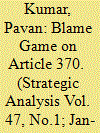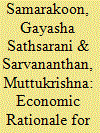|
|
|
Sort Order |
|
|
|
Items / Page
|
|
|
|
|
|
|
| Srl | Item |
| 1 |
ID:
191585


|
|
|
|
|
| Summary/Abstract |
On 5 August 2019, India’s Prime Minister Narendra Modi took a bold decision and made drastic changes to Article 370 of the Indian Constitution, thus changing the legal status of the state of Jammu and Kashmir. This further sparked a debate over the real architect of the Article. There has been a lot of debate and discussion around Article 370. Article 370 provided a special status to the state of Jammu and Kashmir. The debate around Article 370 is highly political, biased, and targeted. It is either blaming Jawaharlal Nehru for the Article or proving that Vallabhbhai Patel was the real architect of the Article.Footnote1 This Essay goes beyond this narrow debate and looks into the available documents for a more authentic picture of the Article and Vallabhbhai Patel’s approach to it. The story of Article 370 follows the following trajectory.
|
|
|
|
|
|
|
|
|
|
|
|
|
|
|
|
| 2 |
ID:
191584


|
|
|
|
|
| Summary/Abstract |
The Governments of India and Sri Lanka signed a Memorandum of Understanding (MoU) to build a bridge across the Palk Strait in July 2002 to join the island nation with the mainland of South Asia by road and rail. The objective of this article is to highlight the likely impact the proposed bridge would have on trade in goods and services and travel between the two countries and beyond. The overall argument herein is that any development activity would have positive and negative outcomes and that on a balance of probability, the positive outcomes of the proposed bridge could outweigh the negative outcomes. The proposed bridge across the Palk Strait could be an alternative to the proposed Sethusamudram project (that could potentially cause environmental damage) rekindled by the Tamil Nadu state assembly in January 2023 in order to stimulate economic growth in the lagging southern parts of Tamil Nadu.
|
|
|
|
|
|
|
|
|
|
|
|
|
|
|
|
| 3 |
ID:
191586


|
|
|
|
|
| Summary/Abstract |
Large-scale disasters have far-reaching impacts that transcend national borders, making a coordinated, “one region-one response” approach essential, particularly in the wake of the COVID-19 pandemic. The Bay of Bengal region has recognized this need and is actively developing structures for regional cooperation, including in disaster management. However, there is a pressing need for a structural framework that enables a coordinated, multilateral, and regional response through the Bay of Bengal Initiative for Multi-Sectoral Technical and Economic Cooperation (BIMSTEC).To this end, this study analyzes the benefits of flat structures over hierarchical structures in the dynamic management of disaster response when various responders, including government officials, military, NGOs, volunteers, and the community, must quickly engage, pass information, take decisions, coordinate, and collaborate to work efficiently in the chaotic post-disaster environment. A structured questionnaire was administered to a stratified sample of 127 respondents, and the resulting quantitative data suggests that information management and coordination, initiative and quick decisions, and adaptability and flexibility are key enablers of effective disaster response. Emerging acceptance trends also indicate that flat structures are more beneficial than hierarchical structures.While accountability, value addition at each level, and conflict resolution were noted as major benefits of hierarchical structures, responders across strata indicated that these factors are not a priority in a disaster response scenario. The study's recommendations cater to the differing aspirations of all strata of stakeholders and should assist in creating an optimal regional disaster response structure for the Bay of Bengal region. By highlighting the importance of a coordinated and multilateral approach, this study underscores the urgent need for regional cooperation in disaster management and the potential benefits of flat structures in enabling effective disaster response.
|
|
|
|
|
|
|
|
|
|
|
|
|
|
|
|
| 4 |
ID:
191583


|
|
|
|
|
| Summary/Abstract |
The past few years have been tumultuous for the Chinese State and big-tech relations. The ground reality for the big-tech internet companies in China has transformed from being indulgent and overreaching to scrutiny and crackdown. This article attempts to analyse the dynamics between the Chinese State and big tech, taking Alibaba’s journey as a case study. This article departs from earlier studies by examining the case of Alibaba within a set of common trends and assumptions about State-big tech dynamics, which are also seen emerging in China. It argues that the unfolding trends follow a pattern that targets certain platform companies and ultimately motivates them to go global. It also highlights that Xi Jinping’s stricter control of the Party and bureaucracy, and renewed emphasis on Mao Zedong’s thought is bringing stricter scrutiny for private enterprises.
|
|
|
|
|
|
|
|
|
|
|
|
|
|
|
|
| 5 |
ID:
191582


|
|
|
|
|
| Summary/Abstract |
The killing of Qassem Soleimani in 2020 again brought the religio-cultural significance of ‘martyrdom’ into limelight in Iran. He got recognized as the ‘Defender-Martyr of Holy Shrine’ given his role against ISIS in protecting the Shi’i holy shrines. This article analyses the relationship between ‘shrines and ‘martyrdom’ in Iran’s strategy against ISIS. It uses the strategic culture approach to understand Iran’s threat perception of ISIS and how the narratives of ‘defence of shrines’ and ‘martyrdom-seeking’ reinforce each other in Iran’s support to the ‘Defenders of Holy Shrines’. It analyses socialization in the Shi’i religious culture on the part of the Iranian policy elite, which influenced Iran’s strategic preferences against ISIS.
|
|
|
|
|
|
|
|
|
|
|
|
|
|
|
|
|
|
|
|
|